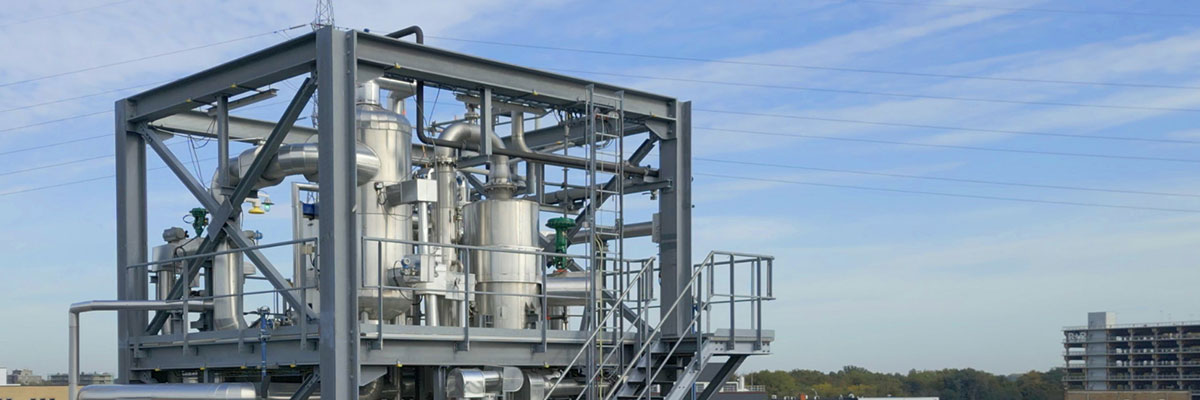Carbon neutral energy with Qpinch and the AlfaCond heat exchanger
Alfa Laval's AlfaCond gasketed plate heat exchanger supports the Qpinch technology to lift residual heat into reusable energy - a winning collaboration to realize the best results in large-scale energy efficiency for heavy-duty industries.
DATE 2023-11-28With the support of Alfa Laval’s expert heat transfer technology, Qpinch have been able to scale up their processes and provide a superior solution for reusing waste heat. This Belgium based waste heat recovery company can now make their process as efficient as possible on an industrial scale thanks to Alfa Laval’s gasketed plate heat exchangers. Combining Alfa Laval’s expert heat transfer knowledge with Qpinch’s unique solution to upgrade waste heat into valuable process heat has resulted in more effective results for even the most heavy-duty industries.
Recovering all available waste heat and transforming it into carbon-neutral process heat is no easy feat. It requires a variety of technical solutions and a lot of expertise. Qpinch and their QHT (Qpinch Heat Transformer) technology have revolutionized this concept, making it possible for even the heaviest duty applications to boost energy efficiency and turn waste into tangible profits.
As their business continues to grow, they turned to Alfa Laval for support as they upgraded their solution from laboratory to industrial scale. They needed to find a heat exchanger design that could cope with new requirements without compromising on the performance and reliability of their existing product.
Each Qpinch unit is designed using a lot of heat exchangers, which is why we chose to include Alfa Laval in the design processes. With the support of their heat transfer knowledge at this stage, we know that our units are the most energy efficient option.
Wouter Ducheyne , Co-founder and CTO at Qpinch
The Qpinch heat transformer is inspired by nature’s own energy system, as it imitates the ATP/ADP cycle that is found in living cells. The Qpinch technology uses an inorganic reversible reaction involving phosphoric acid to create high process temperatures. This chemical reaction takes place in a closed loop between two reactors. On the cold side of the reactor phosphoric acid is indirectly exposed to waste heat, which triggers an endothermic reaction. This reaction causes the acid to oligomerize (from a monomer to a dimer) and thereby capture any waste heat. The dimer phosphoric acid is then transferred to the second reactor (the hot side), where the acid is forced back to its monomer state. This reaction is exothermic and generates reusable process heat. Put more simply, the QHT is designed to recover residual heat that is equal to or higher than 80°C and transforms it into useful process heat at temperatures up to 210°C. It does this using a physiochemical process that requires marginal electrical input.
Alfa Laval adds important value to each Qpinch unit by providing heat transfer solutions that are tailor-made for their unique requirements. The efficiency of the Qpinch heat transformer is dependent on the temperature and pressure of the condensation. The lower the temperature and pressure are, the more efficient the process will be. In this case, the Alfa Laval AlfaCond was selected as the most effective option, as it is specifically designed for condensation under a vacuum. This meant that they could maintain optimum pressure and temperature levels, maximizing reliability and performance for their customers. This partnership, which has challenged the limits of temperature regulation, made it possible for both companies to combine their skills and push the boundaries in their respective fields.
We are so excited about this partnership with Qpinch, as it provides a great opportunity for us to support efficient waste heat recovery solutions for subsequent reuse.
Julien Gennetier, Vice president of the Energy Division and Head of Business Unit GPHE at Alfa Laval
Fact Box
The AlfaCond is a plate surface condenser designed for condensation under vacuum. Using Alfa Laval’s semi-welded technology, vapor can be condensed in the welded channel and the cooling medium can pass through the gasketed channel.
Benefits of the AlfaCond:
- Optional sub-cooling of condensate and non-condensable gases
- Flexible configuration – heat transfer area can be modified
- Easy to install – compact design
- High serviceability – easy to open for inspection and easy to clean by CIP
- Access to Alfa Laval’s global service network

